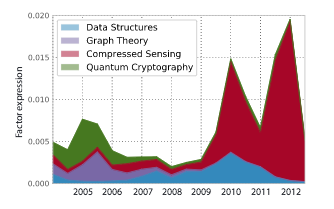Dynamic Poisson Factorization
Models for recommender systems use latent factors to explain the preferences and behaviors of users with respect to a set of items (e.g., movies, books, academic papers). Typically, the latent factors are assumed to be static and, given these factors, the observed preferences and behaviors of users are assumed to be generated without order. These assumptions limit the explorative and predictive capabilities of such models, since users’ interests and item popularity may evolve over time. To address this, we propose dPF, a dynamic matrix factorization model based on the recent Poisson factorization model for recommendations. dPF models the time evolving latent factors with a Kalman filter and the actions with Poisson distributions. We derive a scalable variational inference algorithm to infer the latent factors. Finally, we demonstrate dPF on 10 years of user click data from arXiv.org, one of the largest repository of scientific papers and a formidable source of information about the behavior of scientists. Empirically we show performance improvement over both static and, more recently proposed, dynamic recommendation models. We also provide a thorough exploration of the inferred posteriors over the latent variables.

Reference
Laurent Charlin, Rajesh Ranganath, James McInerney, and David M. Blei, Dynamic Poisson Factorization, in: Proceedings of the 9th ACM Conference on Recommender Systems (RecSys). ACM, New York, NY, USA, 155-162, 2015






